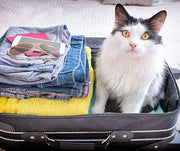Renting With Pets 101: Finding Pet-Friendly Living

Moving is stressful enough as it is and adding pets into the mix only complicates it further. For most of us, rehoming our pets elsewhere is simply out of the question. After all, our pets are beloved members of the family.
Unfortunately, if you're looking to rent, having a pet usually adds additional obstacles. Not all landlords allow pets, and for the ones that do, you'll likely face breed and weight restrictions. This is the biggest hurdle faced by pet owners looking to lease or rent. You might find the perfect apartment that checks all of your boxes, only to find out the complex has a strict no pets policy.
Roughly 68% of American households have at least one pet, yet according to a landlord survey by Avail, only about 55% of landlords allow pets. So, if you're thinking about moving soon and need to put together a game plan for bringing your dog or cat along with you, this guide is for you.
Why Do Some Landlords Ban Pets?
On the surface, a no pet policy can seem overbearing, outdated, and maybe even a little mean. However, landlords and property owners have many legitimate reasons for not allowing pets on their property. It might not even be the landlord's personal decision, as some condo associations as a while do not allow pets.
Below are some of the most common reasons rental properties decide not to allow pets on their premises.
Pets Can Cause Property Damage
While every pet parent loves to believe that their precious dog or cat could never cause damage, you simply never know. No matter how well-trained your pet is, an animal still has their natural instincts. Common property damage caused by pets includes scratch marks, destroyed landscaping, carpet stains, and chewed-up wood.
Pets Can Be Noisy
Pets, especially dogs, can be noisy. This can be especially problematic if you live in a high-traffic area. Mail carriers, delivery drivers, and foot traffic can be tempting for certain dogs. The last thing a landlord wants to deal with is multiple noise complaints from neighbors.
Pet Allergies
While your landlord may not be allergic to dogs or cats themselves, they still need to take other and future tenants into consideration. Depending on the ventilation system set up, allergens and fur can spread to other areas via air conditioning ducts. Having a general no pet policy can be comforting to potential tenants with severe allergies to pets.
Risk of Injuries
Landlords may ban pets from their properties to prevent incidents such as dog bites, which can be litigious and expensive.
Finding a Pet-Friendly Apartment
Here are some things to keep in mind when looking for a new place to call home.
Give Yourself Enough Time
If you've made it this far, you're already aware of how difficult it can be to find a pet-friendly place to rent. Starting your research as early as possible helps maximize your chances of finding something suitable, especially if you've got a large dog. With plenty of obstacles already, the last thing you want is time working against you too.
Ask Around
Ask friends, family members, or even current neighbors if they know of any pet-friendly rental communities or properties nearby. They may know of pet-friendly "for rent by owner" options that may not be as heavily advertised online or elsewhere.
If you're not staying local, check to see if the area you plan on moving to has any renter resources you can use.
Consider Creating a Resume for Your Pet
With many valid reasons for landlords to not allow pets, consider drafting a "pet resume" that showcases your pet's best qualities. Try to explain why your pet would be a good fit for the community and include any other information that may boost your chances, such as their personality type, any training they've had, and so on. You can even include pet references from previous landlords, neighbors, or roommates vouching for your responsibility.
Be Honest About Your Pets
Never sneak pets into a rental property that doesn't allow them. Doing so could lead to heavy fines, eviction, or other serious consequences. If you've found a property you really love that doesn't allow pets, you can always try asking and pleading your case. Keep in mind, however, that most policies that state "no pets," really mean no pets.
You'll Likely Have to Pay Additional Fees
If the property accepts pets, be prepared to fork over additional cash. Many landlords require a pet deposit that may or may not be refundable, as well as an extra monthly pet fee included in your rent every month.
Once You Move In
Finally finding a property that meets your needs and allows you to bring your pets along can be a huge sign of relief. The work isn't over, however. You still need to adhere to the terms of your lease and prove yourself as a responsible tenant and pet owner.
Don't Leave Pet Unattended For Too Long
Try not to leave your pet unattended for extended periods of time, especially when you've just moved in. Your pets are unfamiliar with their new surroundings and may act out in fear or anxiety, causing damage while you're away. Make sure they've adjusted to their new home before leaving them alone for a long time. It's probably a good idea to make sure your dog is properly crate trained to prevent any damage while you're away.
Commit to Regular Walks
If you have a dog, daily walks are a must! An un-walked dog with pent-up energy is a recipe for destructive chewing.
Have Toys and Entertainment on Hand
A critical part of preventing destructive chewing or other damage is having plenty of toys and stimulation on hand. Interactive dog and cat toys, puzzle treat toys, scratching posts, and cat trees are great for enriching your pets.
Clean Up After Your Pets
This one should be a no-brainer, but it's important enough that we're including it anyway. If your pet has an accident inside the property, clean it up immediately before the stain and odors set in. This not only keeps your living space tidy but can also prevent you from having to extra fees when you move out.
Conclusion
Renting a new place to call home when you have pets can be a stressful process, but if the right steps are taken, it is worth it. Good luck on the search for your next home!
Sources:
- https://www.bettercitiesforpets.com/resource/renting-with-pets/
- https://be.chewy.com/ask-an-expert-what-you-need-to-know-about-renting-with-pets/
- https://allpropertyservices.com/tips-renting-with-pets/
- https://www.humanesociety.org/resources/information-renters-pets
- https://www.avail.co/education/articles/should-you-allow-pets-in-your-rental-property
Previous article

Next article

Related posts
View all-

National K9 Veterans Day: Why and How to Celebrate
National K9 Veterans Day is celebrated every year on March 13th. This year its on Saturday March 13th, 2024. This day was established to recognize and celebrate the contributions that Military Working Dogs.
Read Article -

Puppy Training Tips
Training your pup from day one helps set a solid foundation for good behavior and a well-adjusted adult dog. Puppies thrive on structure, and a predictable routine makes learning easier.
Read Article -

Spring Cleaning Tips for Pet Parents
Say goodbye to the winter germs and hello to all the new spring smells! The beginning of spring is the perfect time to clean your house. For pet owners, this can mean more in-depth cleaning in areas other people don't have to worry about. We will give you some helpful tips and tricks so that cleaning up after your pet seems a little less daunting. Read Article



